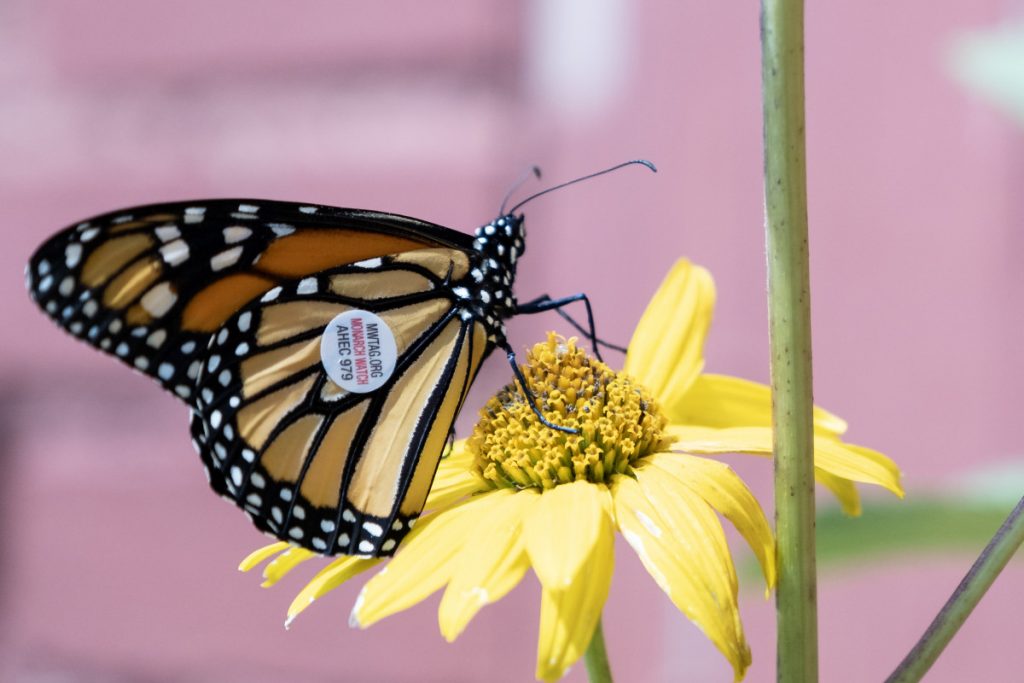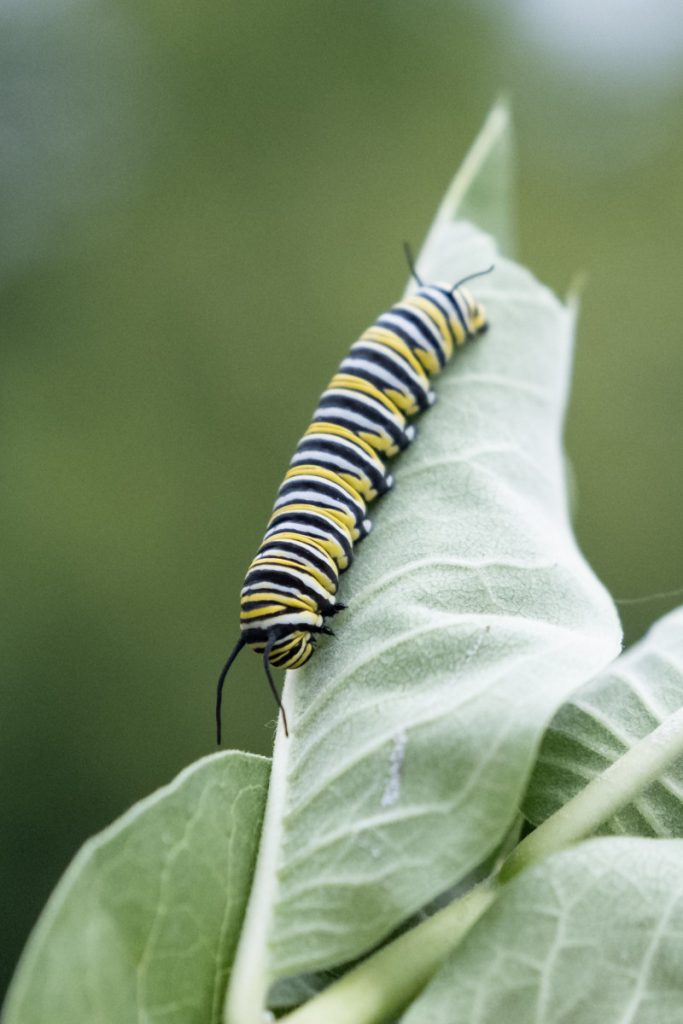
Story by Mariia Novoselia, Photos by HG Biggs
Around a decade ago, Betsy Burgeson, supervisor of gardens and landscapes at Chautauqua Institution, released her two daughters’ first monarch butterfly. She called it Myrtle.
Since then, Myrtle the Monarch is the only butterfly Burgeson’s released that’s been given a name.
“We usually release 100 of them,” she said. “You start out with one, and then I feel bad if I name one and not all the others.”
On Monday, Burgeson collected more than 80 new monarch butterfly eggs, bringing this year’s current grand total to 125. She said it’s a great start, considering how late the first butterflies appeared this season.
“I’m glad we’re finding so many eggs and caterpillars, because I was really worried,” she said.
In the past, Burgeson said, she would see the first monarchs of the season in the middle of May, which was rather early. Normally, she said, frequent sightings occur in early July; this year, however, there were only a couple here and there across the grounds at the time.
“We find their eggs all over the place, but there are definitely not as many as in past years. Hopefully, the little bits that we’re doing here will help out,” Burgeson said.

Every egg, she said, has a 10% chance of survival in the wild; raising eggs, on the other hand, increases the likelihood of them turning into caterpillars by up to 90%. “All sorts of different things,” including pathogens, viruses, bacteria and fungus, can fatally affect a monarch egg, Burgeson said.
A female monarch can lay from 100 to 300 eggs during her lifetime, according to the U.S. Forest Service. It takes about three to four days for an egg to hatch and turn into a caterpillar, Burgeson said.
Currently, she said she has over 20 caterpillars in her workshop across Rt. 394.
“I’ve been raising monarchs since I could walk. My mom and dad used to say: ‘Go look for caterpillars and see what you can find,’ and I remember raising them as a little kid,” Burgeson said, noting that she realized her kids were not seeing as many monarchs as she used to when she was their age.

Between 10 to 12 days after hatching, caterpillars, she said, hang themselves up from a branch or a twig in a j-like shape. Soon after that, they shed their caterpillar skin and turn into chrysalids. Wilting antennae, Burgeson said, signal the imminence of the transition.
While in the chrysalid, future monarchs are still vulnerable to diseases like the Black Death, she said. The malady can be caused by pseudomonas bacteria or the nuclear polyhedrosis virus, according to saveourmonarchs.org. In the event of catching the Black Death, a monarch’s chrysalid turns black and mushy, Burgeson said.
Metamorphosis takes around 10 to 12 days. After monarchs emerge out of their chrysalids, they need from two to four hours to dry their wings, Burgeson said. Then, when they are ready to take flight, people can tag them, using a special kit.
Volunteer-based monarchwatch.org sells tagging kits and provides instructions on how to attach a special sticker with a number on it, used for tracking monarchs as they migrate across the continent.

“You write down the number, you write down whether it’s a boy or girl butterfly, and then you just let it go,” Burgeson said.
Male monarchs, she said, have two distinctive black pouches on the lower part of their wings, which makes it easy to tell them apart from female ones.
Monarchwatch.org also allows people to register when and where they see monarchs, which is why Burgeson said she often refreshes the website to see if any of the butterflies she tagged and let go into the wild were spotted on their way to “Mexico or anywhere along that journey.”
“I really hope that someday we will get one of our numbers to show up down there,” she said.
A monarch’s life cycle, Burgeson said, is absolutely amazing. Usually, there are four generations per season, and the monarchs born on the grounds of Chautauqua belong to the fourth one, called methuselah.
Methuselah monarchs embark on a transcontinental journey all the way to Mexico, where they stay until January or February, Burgeson said. Then, she said, they fly back up to southern states like Texas, where they “have some fun, lay some eggs, and then die out.” Next generations fly to states further north: It takes three generations for them to get to a region like Chautauqua, Burgeson said.
Fourth-generation monarchs, she said, put on more fat for their big flights and have bigger abdomens, as well as lifespans – while the other generations live between four to six weeks, methuselah monarchs are around for up to eight months.
“That fourth generation blows my mind every time I think about it,” Burgeson said.
If she had the chance to start over and go back to college, Burgeson would probably study monarch butterflies because of how fascinating they are — or maybe not, she said, so as not to lose her sense of awe.

After all, many have advised against meeting your heroes, let alone studying their life cycles.
Monarch butterflies, Burgeson said, are enormously important for the ecosystem because they are pollinators. And while “they are not something that gets eaten a whole lot,” she said, removing them from the system web would lead to its collapse.
Nectar sources are crucial for monarch butterflies, and habitat loss is one of the biggest threats that they face, Burgeson said. In order to help butterflies protect themselves, she and her team refrain from cutting down some grasses on the grounds – on a windy day, monarchs can hide in the long stems.
Chautauquans can also help by opting for annual plants that serve as good nectar sources. Since monarchs lay their eggs on milkweed, planting it in a garden also helps the butterflies, but Burgeson advises against the common milkweed, as that’s a very aggressive species.
Placing a couple of flat rocks around gardens for the butterflies to puddle in, as well as looking for eggs and bringing them to Burgeson would also be appreciated, she said.

Burgeson has been working on the grounds of Chautauqua Institution since January 2015. In 2016, together with her team, she installed the first monarch butterfly waystation on the grounds, by Smith Wilkes Hall. At that time, there were only over 13,500 certified monarch waystations in the world, she said. Now, there are over 44,000.
Having a monarch waystation certified entails making sure it has all the things for monarchs to sustain themselves, like nectar sources or milkweed, and refusing to use pesticides or herbicides, Burgeson said. There are many certified monarch waystations not only on the grounds of the Institution, but also in Chautauqua County, she said.
“You don’t have to have a gigantic, huge open space to have a monarch waystation. It literally can be three pots on your porch, and that can be considered a waystation,” Burgeson said.
Monarchs are special for Burgeson because of how striking they are visually, and because they’re something everyone can bond over. Showing monarchs in different stages of life elicits the same reaction from 2-year-olds or 95-year-olds.
“It’s the wonder of what they are, how they exist and how quickly you can see the transition,” she said, noting that in a world where “everything needs to be instant,” watching monarchs transform satisfies both the longing for more immediate gratification, and a long-term connection with nature.
Many people, Burgeson said, tell her they remember taking care of monarchs when they were children.
“You can still do it. You can be a kid at any age,” she said. “A lot of people want to have some kind of impact on the world, and that is something you can do easily enough.”




